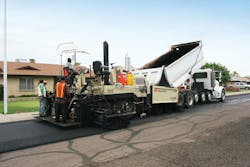Rubberizing roads
The state of Arizona is a pioneer in the use of rubberized asphalt. Every year, Phoenix—the state’s largest metropolitan area—replaces residential streets with a rubberized asphalt overlay. This year, four miles of streets and more than 84,000 tons of rubberized asphalt is being laid in north Phoenix by M.R. Tanner Construction.
The rubber in rubberized asphalt performs two functions: it works as a binder and as a filler component. Because rubber is included in the binder, rubberized asphalt consists of a higher percentage of binder than conventional asphalts. When rubberized asphalt is made, the rubber in the binder is not completely melted because the rubber, employed as a filler, must carry some of the load. Recycled tires are used to produce the rubber, which in asphalt provides better elasticity, and makes it more resistant to rutting and quieter to drive on.
“The rubberized asphalt needs to be compacted above 240°F,” said Ralph Conklin, paving foreman for M.R. Tanner.
To ensure the asphalt makes it to the jobsite at the proper temperature, the company has 18 trucks transporting the asphalt. Additional trucks are added during the morning and evening rush hours, avoiding busy freeways and utilizing city streets.
Rubberized asphalt must be laid quickly to maintain the proper temperature for compaction. M.R. Tanner uses an Ingersoll Rand PF-3200 paver and lays the material at 300°F for this application. The PF-3200 was chosen because it’s driven by wheels.
“Wheeled pavers move faster and are easier to turn, which is a benefit when we’re working in residential areas like this, where space is sometimes tight,” said Conklin.
With a paver moving so fast, the breakdown compactor needs to keep up. M.R. Tanner uses an Ingersoll Rand DD-118HFA. “This is a fast compactor, making it ideal for this job,” Conklin said.
An Ingersoll Rand DD-90 works as the finish compactor. After compaction, limewater is placed on the asphalt.
“The water evaporates and the lime removes the tackiness from the asphalt,” Conklin said. This allows the pavement to be used within 15 minutes after compaction is completed. By working quickly, M.R. Tanner is providing the residents of Phoenix with a quiet, durable asphalt and minimal interruption to traffic.
